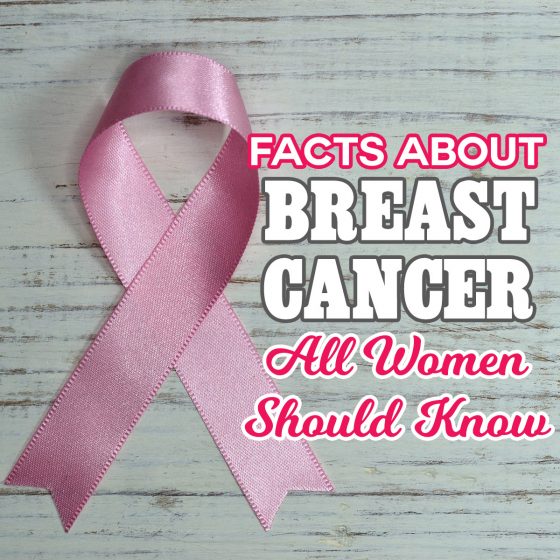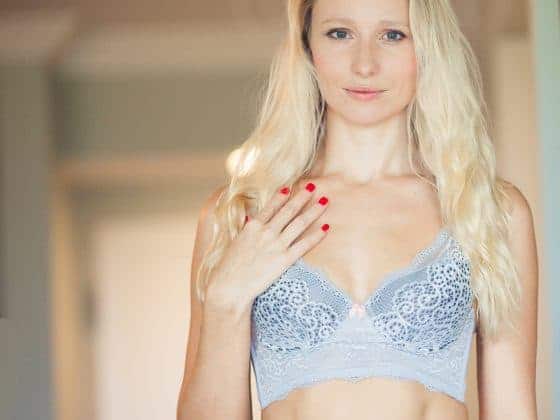There are over 3 million women in the U.S. with a history of breast cancer. October is National Breast Cancer Awareness Month, so we’ve compiled important facts about breast cancer that all women should know and understand. Over 250,000 new cases of breast cancer in women are projected for 2017. In addition, about 2,500 men are expected to be diagnosed with breast cancer this year. There is tons of research and information available on breast cancer, but there is never too much awareness on this devastating cancer. We at Daily Mom support breast cancer awareness and research and admire the strength of all women who have fallen victim to breast cancer. This article is intended to encourage our readers to learn about breast cancer and take the necessary steps to maintain their health.
Understanding Facts About Breast Cancer

Breast cancer is an uncontrolled growth of breast cells. Cancer occurs as a result of mutations or abnormal changes in the genes that are responsible for regulating the growth of cells and keeping them healthy. When learning facts about breast cancer or dealing with a diagnosis, you will hear many terms. Some of these terms are complicated and confusing. It can become overwhelming, especially if you have just received some bad news. Even if you do not experience breast cancer yourself, it is important to educate yourself on these terms. We have complied a list of some pertinent words and phrases to better understand breast cancer.
- Benign
- status of a tumor not considered dangerous
- Chemotherapy
- treatment that uses medicine to weaken and destroy cancer cells in the body
- Malignant
- status of a tumor that has the potential to be dangerous
- Mammogram
- an x-ray that examines the breast tissue for any suspicious area
- Metastatic
- the cancer has spread beyond the region of the body where it was first found
- Nodes
- small filters found throughout the body and especially dense in and around the breast
- Tumor
- the lump of cancer found in the breast itself
- Stage 0
- the cancer has been diagnosed early
- Stage 1
- the cancer has broken free to attack healthy tissue
- Stage 2
- the cancer has grown, spread, or both
- Stage 3
- the cancer has not spread to bones or organs but it’s considered advanced and is harder to fight
- Stage 4
- breast cancer cells have spread far away from the breast and lymph nodes right around it
Risk Factors
Breast cancer affects all types of women through various stages of their life. Although there are many risk factors beyond our control, there are certain things that can be done to lower the risk of breast cancer.

Risk Factors You CAN’T Control
Gender
Age
Family history of breast cancer
Personal history of breast cancer
Race
Radiation therapy to chest
Breast cellular changes
Exposure to estrogen
Breastfeeding
Risk Factors You CAN Control
Weight
Diet
Exercise
Alcohol consumption
Smoking
Recent oral contraceptive use
Stress and anxiety
Warning Signs

One in eight women in the U.S. will develop breast cancer over the course of their lifetime. At first, a person may not experience any symptoms of breast cancer, however, your breasts may experience changes that point to breast cancer. If you experience any symptoms that you are unsure the seriousness of, you should notify your doctor and get checked out. Some signs and symptoms to look for are:
- Swelling on all or part of the breast
- Skin irritation
- Dimpling on the breast
- Breast pain
- Nipple pain
- Nipple turning inward
- Redness on the breast
- Scaliness
- Thickening of the nipple or breast skin
- A nipple discharge (other than breast milk)
- A lump in the underarm area
Detecting Breast Cancer

Breast cancer can’t be prevented, but in many cases it can be detected early by regularly getting a breast examination from your doctor, mammograms, and by doing self-exams. Mammograms can detect tumors before they can be felt, which is why screenings are so important. Mammograms are a very important tool by not only detecting breast cancer but continuing to evaluate the status of the cancer. It is recommended that women 40 and older receive a mammogram annually. Women under the age of 40 that have risk factors for breast cancer or have a family history of breast cancer are encouraged to ask their doctors if they should receive mammograms as well.
How To Do a Self-Exam

While examining your breasts, if you feel a lump, schedule an appointment with your doctor; however, do not panic. Eight out of ten lumps are not cancerous.
Step 1
Look at your breasts in the mirror with your hands on your hips. You should be looking for any unusual size, shape, and color. If you notice any changes with your nipple, any bulging of the skin, or redness, notify your doctor.
Step 2
Still looking in the mirror, raise your arms over your head. Continue to look for any abnormal changes. Take note of the contour and shape of your breasts and look for any swelling.
Step 3
Squeeze the nipple to check for any fluid such as a watery, milky, or yellow fluid or blood discharging from the nipples.
Step 4
Lay down and feel your breasts. Use your right hand to feel your left breast and your left hand to feel your right breast. Keeping your fingers flat and together, use a firm, smooth touch while making a circular motion on your breast.
Step 5
Feel your breast while sitting or standing. Cover your entire breast using the same hand movements you performed while lying down. Tip: Perform a self exam in the shower. Many women find it easier when their skin is wet.
Love this article? Help support Daily Mom through our Patreon page.
If you or someone you know becomes diagnosed with breast cancer, it is important to understand your legal rights. For more information, check out Breast Cancer and Your Career: What You Need to Know.
This post is meant for educational purposes only. It is not intended to replace medical advice from your physician, doctor or health care professional. Please read our terms of use for more information.
Sources: Breast Self Exam, What is Breast Cancer?, What are the Stages of Breast Cancer?
Photo Credit: Pixabay, Every Avenue Girl










































